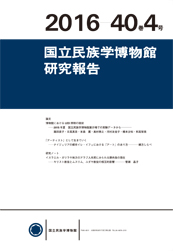Bulletin of the National Museum of Ethnology
Contents
- Articles
- The Current State of LED Museum Lighting: Summer 2015
Naoko Sonoda, Shingo Hidaka, Kaoru Suemori, Yasuyuki Okumura, Yukako Kawamura, Sachi Hashimoto, Tomomi Wadaka - To Live as an Artist: The Way the Arts are Practiced in the City of Ile-Ife, Nigeria
Shirabe Ogata - Research Notes
- Pork Consumption among Israeli Arab Citizens in the Galilee Region:
Interactive Influences among the Christians, Muslims and the Jews
Akiko Sugase
Outline
Articles
The Current State of LED Museum Lighting: Summer 2015
Naoko Sonoda, Shingo Hidaka, Kaoru Suemori, Yasuyuki Okumura,
Yukako Kawamura, Sachi Hashimoto, Tomomi Wadaka
Museums are increasingly using LEDs for lighting. However, there is no clear guidance yet concerning the selection of such lighting. In summer 2015, the National Museum of Ethnology, Japan (Minpaku) decided to introduce LED spotlights in all its exhibition galleries. That led us to conduct a lighting experiment, taking 25 measurements on 23 models from six manufacturers (selected from nine manufacturers from Japan and abroad). The results of the lighting experiment are summarized in this paper, based on the actual data. The aim of this paper is to evaluate and understand the actual performance of LED spotlights. There is no intention to discuss the relative superiority or inferiority of each manufacturer or model.
The lighting experiment consisted of measuring optical properties under the same conditions (spectral distribution, photon flux density, color temperature, color rendering, all measured under three illuminance levels: maximum value, 100 lx, and 30 lx), and of evaluating how “objects” looked like under each experimental condition. Spectral distribution and photon flux density measurements confirmed that LED spotlights did not shed UV or IR radiation. A color temperature of 3000 K seemed to be the major trend, but for displays in a museum of ethnology, we concluded that it was preferable to simultaneously use 2700 K and 3000 K spotlights (or a color temperature adjustable type).
The results of the lighting experiment demonstrated that color rendering of LED spotlights now equal that of halogen lamps. For all the models tested, it was possible to control the light by dimming. Moreover, we revealed that some models could adjust color temperature, while others had a remotecontrol function. Those results show that a wider choice is now available in the selection of museum lighting. In our museum, the technical requirements for LED spotlights are made based on the existing requirements for halogen lamps, and taking into consideration the above results. The development of the LED is remarkably rapid, but we believe that this report can be utilized as a basic document to examine new products. Although it focused on the lighting used in exhibition displays at an ethnological museum, the information can also serve as a reference for other types of museums.
Key Words:LED spotlight, museum lighting, lighting experiment, optics properties, technical requirements
To Live as an Artist: The Way the Arts are Practiced
in the City of Ile-Ife, Nigeria
Shirabe Ogata
Aiming to reveal how a creator of arts has lived as an artist in both historical and social contexts, this paper aims to examine the way arts exist in Africa, using as its main example the artist Kolawole Olayinka in the city of Ile-Ife, Nigeria. Previous studies of anthropology have investigated the meaning and social functions of art, and exhibitions have been held trying to overcome the inequality of the power relationship between the West and non-West. However, there have been few discussions of art in terms of its relation-ships with local African society and the Western art world from the viewpoint of artists, the creators of arts. Examining Olayinka's life, life history, and the process of his art making and selling, this paper shall attempt to reveal how he lives as he interacts with both the Western art world and his local society.
Key Words:Anthropology of/and art, African art, artist, Nigeria
Research Notes
Pork Consumption among Israeli Arab Citizens in the Galilee Region:
Interactive Influences among the Christians, Muslims and the Jews
Akiko Sugase
Israel, established in the historical region of Palestine as a “Jewish state” based on Zionism, also includes Arab citizens, who account for around 20% of the total population, and of which 8% are Christian.
Unlike Muslims and Jews, who are strictly prohibited from eating pork, the Christians enjoy eating pork, and so almost wholly monopolize the pork production, distribution and consumption in the country. Meanwhile, many Christians hesitate to eat pork today, a tendency that has emerged in the past few decades. It is true that they are influenced by the strict taboos of their neighbor Muslims and Jews, but the biggest reason is the Israeli system of ruling the Arab citizens. Namely, agriculture declined severely, which had formerly been the dominant vocation of the Arab Christians, because of the military rule in the Galilee region from 1948 to 1966. Wild pig hunting was also practically prohibited.
Those policies changed the Arab Christians' idea of pork consumption that had been deeply connected to their agricultural life, and which had formed the basis of their religious identity. The increase in pork aversion among the Arab Christians in Israel shows the damage inflicted on their religious identity.
Key Words:Israel, Christians, Muslims, Jews, pork consumption
 2016-Vol. 40, No. 4
2016-Vol. 40, No. 4




